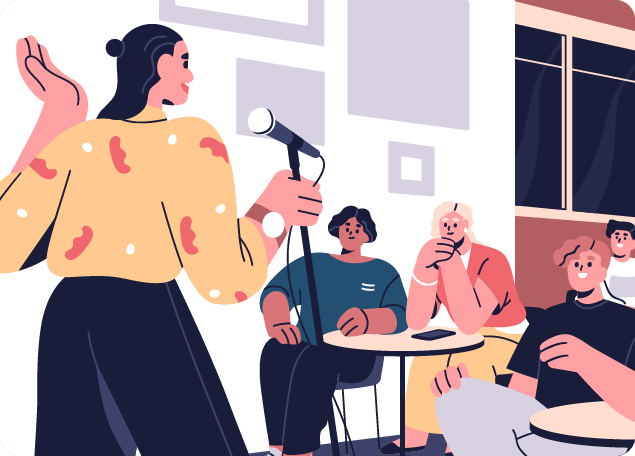Junior Orators: Public Speaking for Kids and Juniors.
| 10 Students |
| 9 - 16 years old |
COURSE DESCRIPTION
Level: Age 9-16
Duration:
1 lesson per week (Customized)
2 – 2.5 hours per lesson (Customized)
Total: 20 lessons
Taught Language: English
Level: From Pre-intermediate / A2-B1
Instructor: Native Speaking Teachers
Group: 5/10 students or 1-1 ( Customized)
Start: Every Week
The aim of this tailored course is to provide young learners with specialized training in public speaking, tailored to their age group. It empowers young learners with essential public speaking skills, fostering confidence, articulation, and effective communication abilities to prepare them for various academic, social, and professional contexts in the future.
Course Highlights:
Age-Appropriate Curriculum: The course offers a curriculum tailored to the developmental stages of children and juniors, ensuring that the content is relevant, engaging, and comprehensible for young learners.
Interactive Learning Activities: Participants engage in various interactive activities designed to enhance their public speaking skills, including role-playing, storytelling, and group discussions, fostering active participation and experiential learning.
Creative Expression: The course encourages creative expression through speech writing and delivery, allowing participants to explore different styles of speeches and develop their unique voices and presentation styles.
Building Confidence: Through structured exercises and supportive feedback, the course focuses on building participants’ confidence in public speaking, helping them overcome stage fright and express themselves confidently in front of an audience.
Audience Participation and Visual Aids: Participants learn techniques for engaging with their audience effectively and incorporating visual aids such as props and slides to enhance their speeches and make them more engaging and memorable.
Key content:
- Building confidence
- Vocal skills
- Leader speech
- Body language
- Palm gesture
- Emcee speech
- Body postures
- Director Speech
- Eye contact
- Salesman speech
- Feet and walking
- Debator Speech
- Facial expression
- Healer Speech
- Speech organization
- Specialist Speech
- Teacher Speech
- Tonality
- Storytelling Speech
- Acting gestures
- Entertainer Speech
Register Now!
Requirements
- Donec porta ultricies urna, faucibus magna dapibus.
- Etiam varius tortor ut ligula facilisis varius in a leo.
- Folutpat tempor tur duis mattis dapibus, felis amet.
- Donec porta ultricies urna, faucibus magna dapibus.
- Etiam varius tortor ut ligula facilisis varius in a leo.
- Folutpat tempor tur duis mattis dapibus, felis amet.
What is the target audience?
- This course is intended for anyone interested in learning to master his or her own body.
- This course is aimed at beginners, so no previous experience with hand balancing skillts is necessary
Aenean viverra tincidunt nibh, in imperdiet nunc. Suspendisse eu ante pretium, consectetur leo at, congue quam. Nullam hendrerit porta ante vitae tristique. Vestibulum ante ipsum primis in faucibus orci luctus et ultrices posuere cubilia Curae; Vestibulum ligula libero, feugiat faucibus mattis eget, pulvinar et ligula.
CURRICULUM
Section 1: Introduction to Handstands
Section 2: Reference Material, Moodboards and Mind Mapping
Wrist Strengthening
While your wrists will certain get stronger from practice and grow accustomed to the stress of the skill, a basic amount of wrist strengthening exercises for several weeks can only help things. I’d recommend working wrist curls and reverse wrist curls for around 6-10 reps for 3 sets. I also strongly recommend trying some sledgehammer levering. Work in 2-3 sets of 3-5 reps. In particular, exercises 1 and 3 are fantastic for building wrist strength and they are much harder than they look! Start with them to get the hang of sledgehammer work before you progress to the other two exercises. I don’t want somebody putting a hole through their floor or their face because they rushed things!Section 3: Sketching out Ideas
- The main objective to the sketching process is to generate super rough thumbnail sketches of what we feel best visually communicates the highlighted words from our mind maps.
- Take as much time as you need for this step — this might be 10 minutes or it might be 10 days.
- Personally, I like to work quickly and try not to analyze or elaborate too much.
- Now, that doesn't mean you should only create a handful of sketches.
- Even though this step only took a couple of hours, I was still able to put over 100 thumbnails on paper.
- The whole point of this process is to flush out the bad ideas and narrow down the good ones until we find that one layout that really speaks to us.
- Also, keep in mind the project brief and have your list in front of you as a reference to avoid getting sidetracked.
- Remember—detail is not needed. Simply flush out the bad ideas and find a great direction.
- Once I feel I have a good direction with the sketches, I'm now ready to take a quick photo with my phone and import it into Illustrator.
Section 4: Conclusions and Evaluation
About Instructors

Reviews
Average Rating
Detailed Rating
| Stars 5 |
|
0 |
| Stars 4 |
|
0 |
| Stars 3 |
|
0 |
| Stars 2 |
|
0 |
| Stars 1 |
|
0 |
Be the first to review “Junior Orators: Public Speaking for Kids and Juniors.” Cancel reply
| 10 Students |
| 9 - 16 years old |


There are no reviews yet.